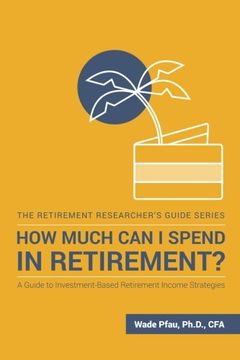How Much can i Spend in Retirement? A Guide to Investment-Based Retirement Income Strategies (The Retirement Researcher Guide Series) (en Inglés)
Reseña del libro "How Much can i Spend in Retirement? A Guide to Investment-Based Retirement Income Strategies (The Retirement Researcher Guide Series) (en Inglés)"
Deciding how much to spend from your investment portfolio in retirement is an important complicated task. This book guides you through the process of determining a reasonable spending rate that will strike the balance between enjoying your early retirement years while preserving enough to be comfortable later in retirement.How much can you spend in retirement? Naturally, this is an essential question for those approaching this important life transition. If you wish to retire one day, you are increasingly responsible for figuring out how to save during your working years and convert your savings into sustainable income for an ever-lengthening number of retirement years. The nature of risk also changes in retirement, as the lifestyle of retirees become more vulnerable to the impacts of market volatility, unknown longevity, and spending shocks. Retirees have one opportunity to build a successful plan. It is not an easy task, but it is manageable and I will explain how to do it.I walk you through the findings of a large body of financial planning research regarding sustainable spending from investment portfolios in the face of a variety of retirement risks. That body of research tends to begin with the 4 percent rule of thumb for retirement spending. I explain how and why it was developed, what it means, and when it may or may not be appropriate for you. I have reservations about the 4 percent rule. It may be too aggressive for current retirees for reasons including increasing longevity, historically low interest rates, high stock market valuations, the impact of the international experience with the 4 percent rule, the need to maintain a rather aggressive asset allocation, and because the 4 percent rule assumes that investors do not pay any fees or otherwise underperform the markets.Other factors suggest that sustainable spending may be higher. Reasons include that actual retirees may tend to reduce their spending with age, that they build more diversified portfolios than used in the basic research studies, that real-world retirees may be willing to adjust spending for realized portfolio performance, and that some retirees may have the capacity and tolerance to accept higher portfolio failure probabilities because they have other sources of reliable income from outside their portfolios.Other matters you will learn about is how to analyze a variety of variable spending strategies and how to create a bucketing strategy that uses bonds to support short-term spending needs and uses stocks and other growth assets to support longer-term spending goals.Retirees need to weigh the consequences between spending too little and spending too much-that is, being too frugal or running out of assets. This book is about implementing what I call the "probability-based" school of thought for retirement planning. It is especially relevant for people who plan to fund their retirements using an investment portfolio and those who are hesitant about using annuities or other insurance products. For those considering annuities, I suggest my book, Safety-First Retirement Planning, which is also in The Retirement Researcher's Guide Series. For now, we have plenty to discuss about investing for retirement.How did I come to write this book? After completing my Ph.D. in Economics from Princeton University with a dissertation about Social Security reform, I become an economics professor who studied the pension systems in different countries. Eventually I gravitated toward individual retirement planning and now work with unique job title of "Professor of Retirement Income" and as director of the Retirement Income Certified Professional(R) designation for financial advisors. This requires me to be agnostic and to search for the best from different retirement income styles.

